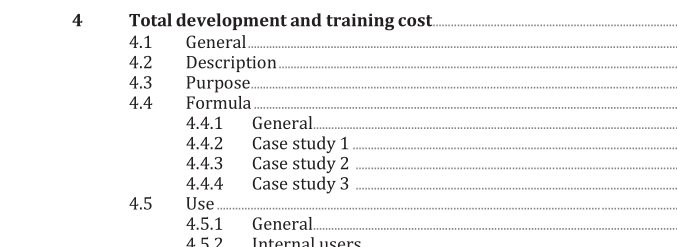ISO TS 30428:2021 pdf download – Human resource management — Skills and capabilities metrics cluster.
4 Total development and training cost 4.1 General Development and training are used to increase the skills and capabilities of the workforce to help an organization accomplish its mission, achieve its goals and meet its needs. Many organizations make significant investments in development and training, and the total development and training cost is an important measure of an organization’s investment in human capital. While cost is an input metric, it is nonetheless an indicator of the organization’s commitment to invest in its workforce, and some research has shown a correlation to better financial performance. ISO 30414 recommends this metric be reported internally and externally by all organizations. 4.2 Description Total development and training cost is the sum of all spending on training and development within an organization. Total cost includes items such as salaries and benefits for the staff, overhead costs (such as supplies), direct costs of conducting the training (such as room rental, materials and travel cost for staff), costs for external suppliers [developers, facilitators, learning management system (LMS) providers] and tuition assistance. NOTE 1 This list is just meant to provide examples of costs to be included. This document calls for all reported training costs to be included. In practice this is measured as the sum of all spending by the internal training departments and the amount spent on tuition assistance for employees to obtain certificates or degrees. If data are available on training expenditures by other departments (not captured by the training departments), this should be added for a more complete picture. It does not include spending on training-related conferences hosted by other organizations or the travel expenditures for non-training department employees to attend training. It also does not include the opportunity cost (value of the time spent in training) of the participants in the training. NOTE 2 Others have defined total cost to include opportunity cost, so it is important to know which definition is being used when benchmarking or comparing to another organization. The addition of opportunity costs produces a more accurate measure of total cost. 4.3 Purpose The purpose of measuring total development and training cost is first to know how much is being spent to develop skills and capabilities so that a judgment can be made about whether more or less should be spent. This is often expressed as an average expenditure per employee or per learner, or as a percentage of payroll or revenue, and varies by organization, depending on the difficulty of the goals and needs as well as the competency rate of the workforce.
ISO TS 30428:2021 pdf download – Human resource management — Skills and capabilities metrics cluster






